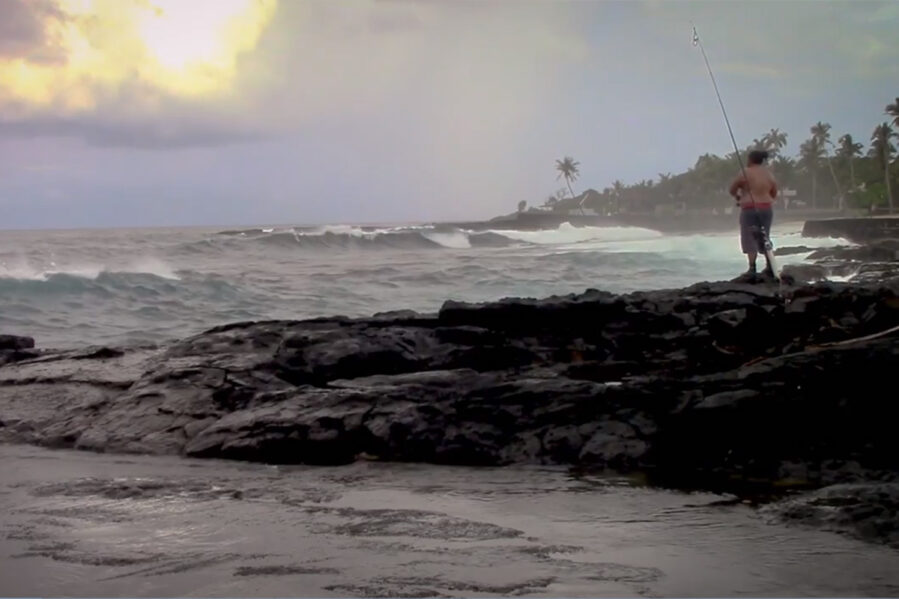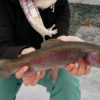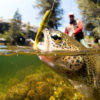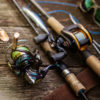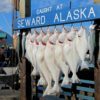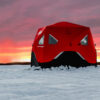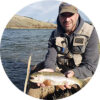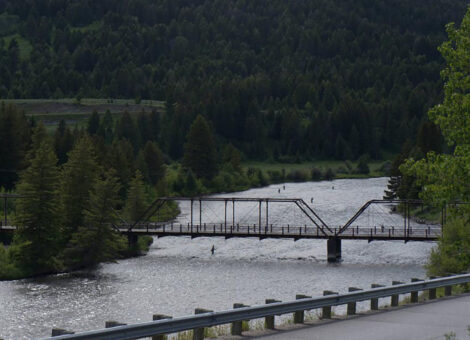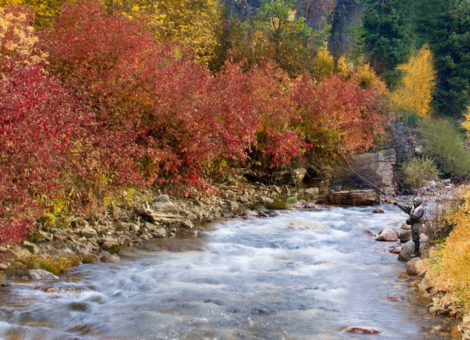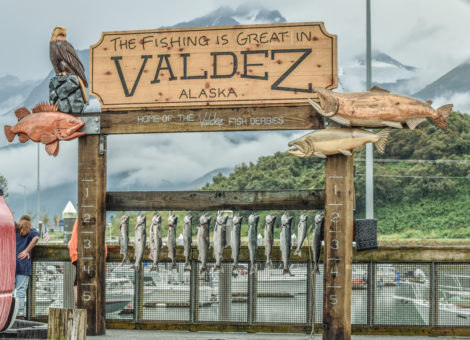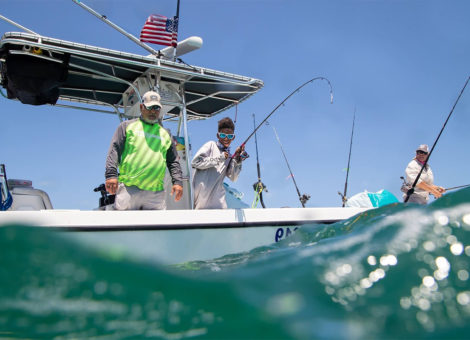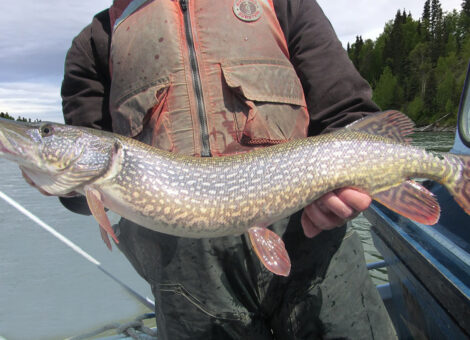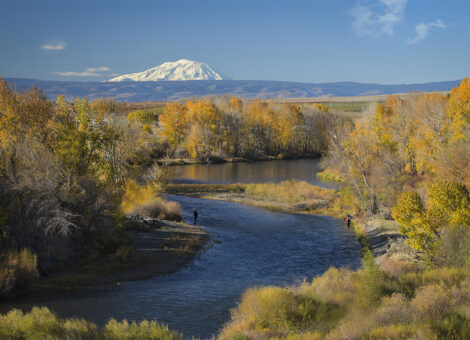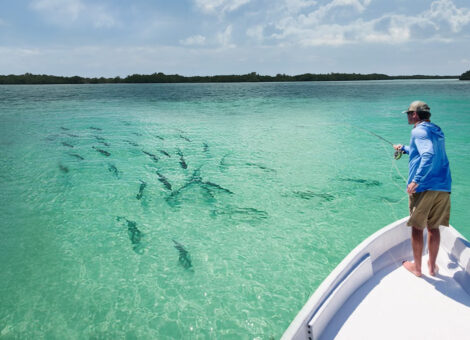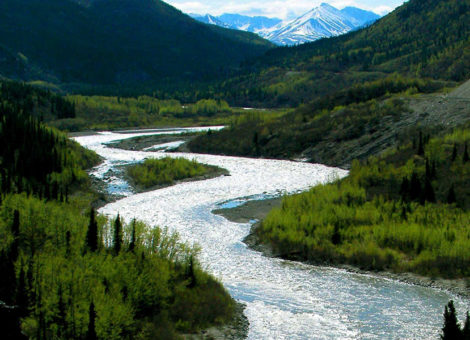American Samoa is home to some of the most sought after fish species in the South Pacific. In fact, if it’s found in the South Pacific, you’re likely to find it in the waters of the Samoan Islands. Some of the more popular sportfish Samoa is known for include snappers, tuna, wahoo and several species of groupers, marlin, emperors, and jacks.
The Ocean and fishing lie at the heart of American Samoa life and culture. Fishing is more than a pastime in Samoa, it’s a way of life. For American Samoans fishing provides a sustainable resource for food, a way to perpertuate and strengthen cultural family practices, and a recreational outlet.
For visiting anglers, American Samoa provides the opportunity to fish one of the world’s most prestine untapped fisheries. Recreational fishing is allowed in the water off American Samoa, but village permission must be obtained before fishing from shore, or on any of the inshore reefs. Beyond the reefs, anglers can fish by charter boat or kayak without obtaining permission.
- Fish Festivals and Events
- Traditional Fishing
- Modern Fishing Methods
- Best Places to Fish
- When to Fish
- Fish Species
- Rules and Regulations
Fish Festivals and Events
Each village on the Samoan Islands has its own fishing traditions and festivals. A few of the more popular “fish” festivals and events that are worth adding to your itinerary are the Atule Harvest, Palolo Rising, Samoan International Game Fishing Tournament and Oka festival.
Atule Harvest
In the village of Fagasa, villagers gather twice a year for the atule (bigeye scad) harvest of “lau”. During the harvest villagers surround schools of bigeye scad in Fagasa Bay using makeshift nets constructed of coconut leaves and vines. The the villagers herd the scad toward the shore where they’re plucked from the water and distribute them among the villagers.
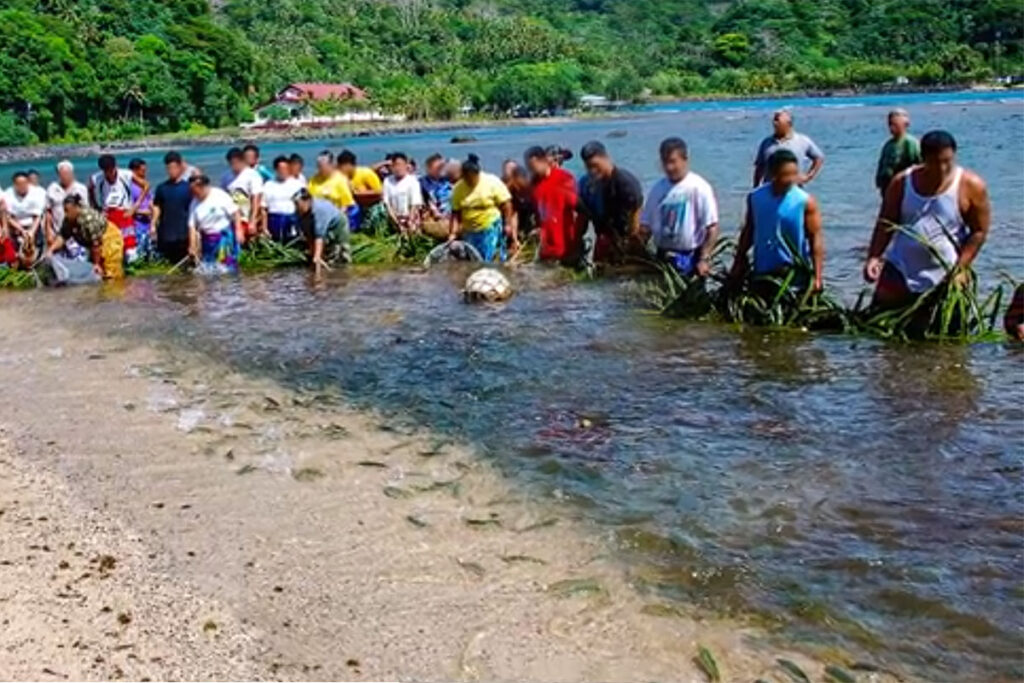
Palolo Rising
Just before dawn, during the annual event of Palolo Rising in late October, islanders flock to the coral reefs just offshore with nets, buckets and lights in paopao (canoes) to harvest the legendary, and incredibly tasty, Palolo Reef Worm. The palolo is said to have a strong salty seafood taste, similar to mussel, oyster or caviar.
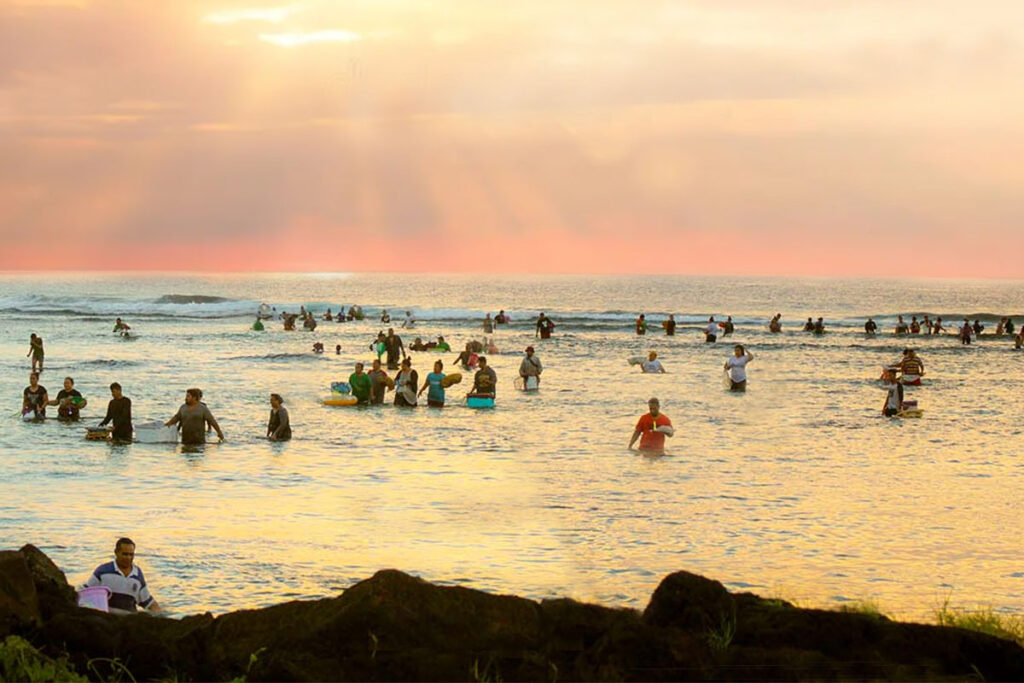
Palolo harvesting sites that are accessible from shore are; Tuialamu (Lalomanu), Matautu Lefaga, Falealili, Salamumu, Falelatai in Upolu, and Safotu, Fagasa, Sataua, Asau, Papa, Puleia, Satupaitea in Savaii. There are several other offshore sites where palolo work can be harvested by boat and known only by the locals.
International Game Fishing Tournament
During late April and early May the Samoan International Game Fishing Tournament (“SIGFA”) draws anglers from around the world for a week of intense tournament fishing and highly-anticipated competition. If you’re an avid anglers looking for a once in a life time experience to add to your bucket list, I’d say this is it.
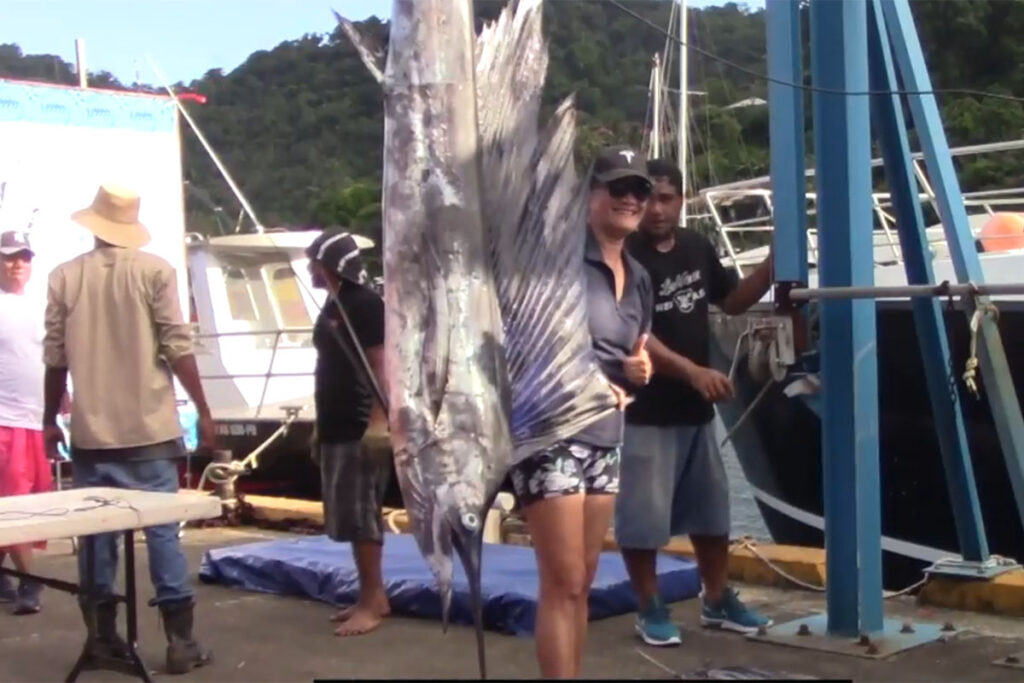
Oka (Raw Fish) Festival
Each year in early December local aspiring chefs battle it out to see who has the best Oka-making skills (raw fish). While this isn’t technically a fishing event, anglers are still invited. I wouldn’t say I’m a sushi lover, or that I even enjoy raw fish, but the Oka fest is a must experience event if you’re in Samoa during December. Teams are judged not only on their oka making skills but by the different variations of accompaniments—such as this year’s palolo (sea worm) dish produced by the Taumeasina Island Resort.
Traditional Fishing
There are five traditional fishing and harvesting methods that are still practiced by the native American Samoans.
- kili – net throwing
- fai ‘ofe – casting
- tuli a’au – sling spearfishing
- enu – trap fishing
- glearning – gathering shelfish
The shallow shorelines and flat bottom inshore bays of Samoa, such as those found around Aloa Village, are the perfect locations to knab schools of passing fish with a kili (throw net). Traditional kili are constructed using the fiber or local trees. Today, kili is made from a monofilament mesh, but villagers continue to use the same net fishing technique employed by their ancestors for hundreds of years.
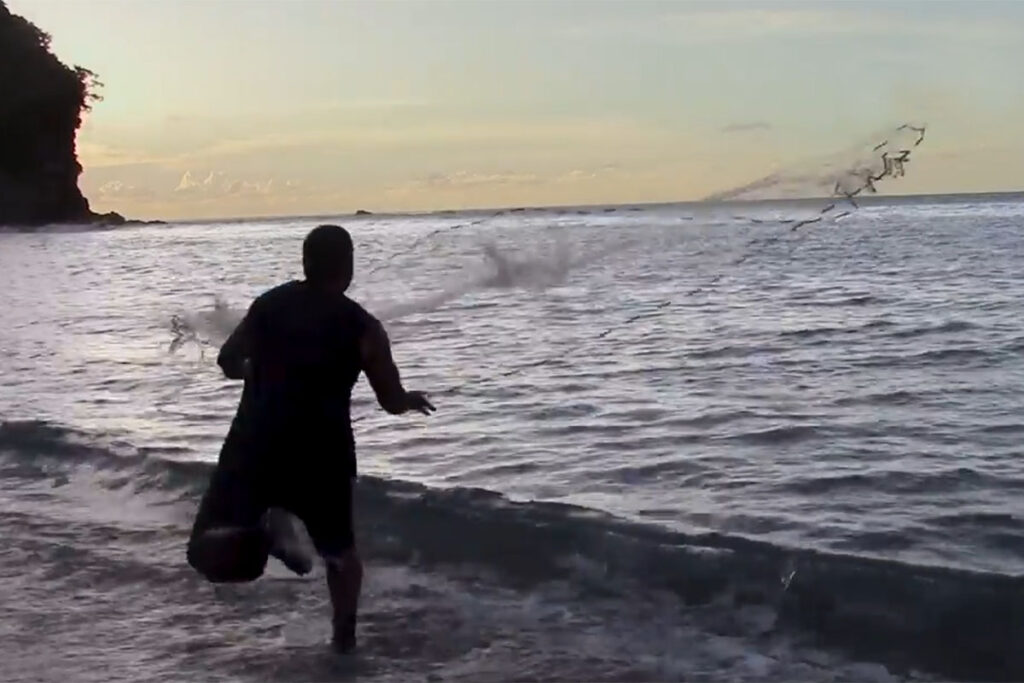
Fai ‘ofe and tuli a’au while not as prevalent today as in times past are still practiced among some villagers. From time to time you can still catch a glimpse of an islander practicing fai ‘ofe (casting) using a traditional rod and reel. And the tradition of tuli a’au, or sling spearfishing, still runs strong among many islanders.
An enu is a fishing trap basket made of ‘ie’ie vines that are lashed together using lengths of braided afa (coconut fiber). It is one of American Samoa’s oldest and most traditional practices, but has largely been replaced by more modern fishing methods. Enu is, however, still alive and well in the village of Ofu where it is practiced along the beaches of the southern coast of Manu’a. The enu traps are baited with uga (hermit crab) meat and buried in the sand near the shoreline during i‘asina (yellowstripe goatfish) runs.
Gleaning, traditionally performed by women and children, is one of the oldest methods of harvesting food from the sea. It has been performed by American Samoan villagers for thousands of years. During low tide, when shallow water reefs become accessible, and tidepools form, harvesters scour the crevices gathering giant clams, octopus, eel, turban snails, and other crustaceans and small fish.
Modern Fishing Methods
While traditional fishing methods have their place among island culture, today more modern fishing methods and equipment are employed by many villagers and recreational anglers. Basic fishing gear you’ll want to bring with you includes a sturdy popper/stick bait rod and spinning reel. If you’re a fly guy you can bring your fly gear.
Surf Fishing
There are couple different ‘Island’ styles of surf fishing on Samoa. Both may use modern tackle, including a spinning setup or fly fishing gear, but one involves fishing from the shore and the other getting out in the surf by wadefishing, kayak, or a combination of the two. Often anglers will take a kayak out into surf, anchor up, and wadefish in the shallows as they cast into the surf.
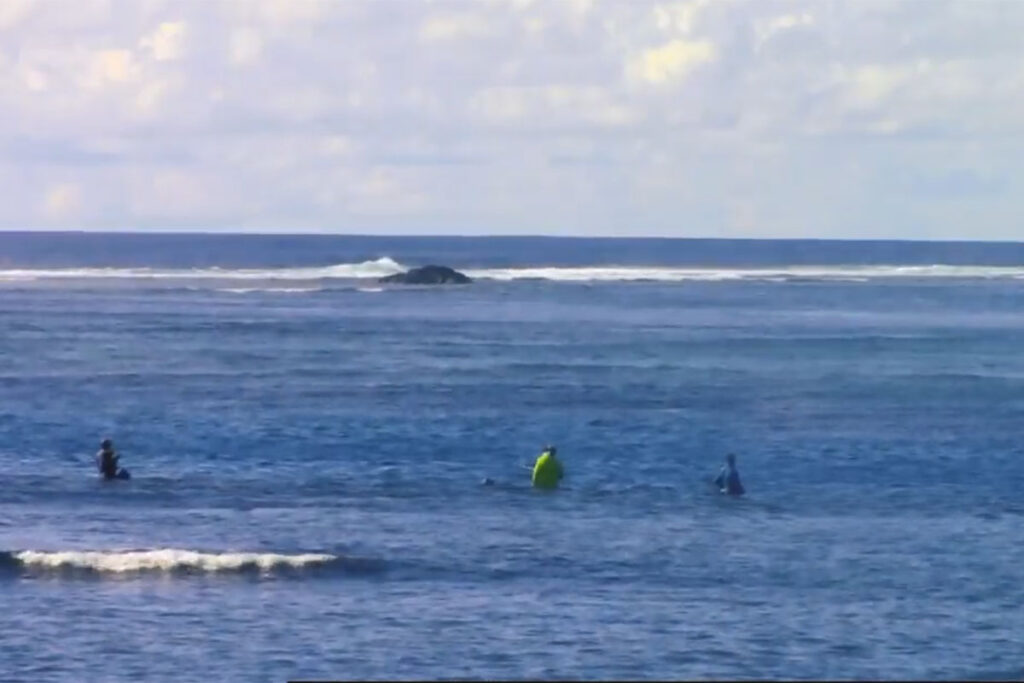
In areas where there are drop-offs, or deeper water, surf fishing from shore, a jettie, or rocky outpost is more of the norm.
Spearfishing
Spearfishing is both a traditional and modern method of fishing in American Samoa. More importantly, it’s dang fun! While gear and techniques have evolved over the years, the fishing method remains largely unchanged. Fisherman can spearfish during the day, evening, and well into the night.
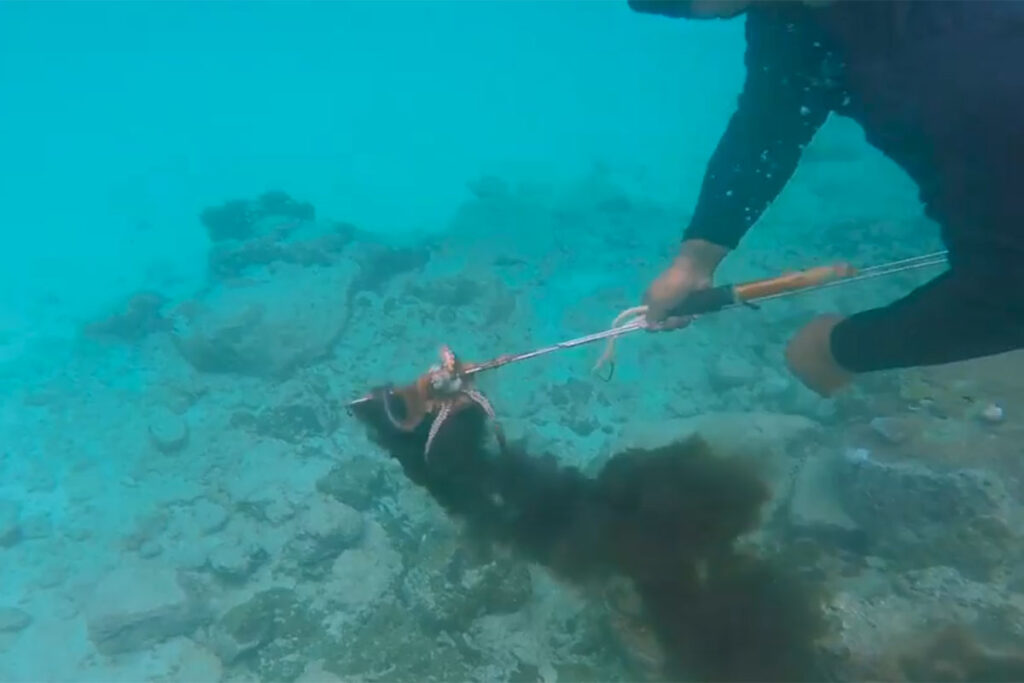
Fishing at night with spears and underwater flashlights is a favorite pastime of locals and quite the adventure for any angler lucky enough to have the opportunity. The reef area off Faga‘alu Beach on Tutuila Island is one of the more popular spearfishing destinations for amberjack, parrotfish, surgeonfish and spiny lobster.
Trolling
Trolling is the primary offshore fishing technique employed in American Samoa. It provides the opportunity to catch Pacific sailfish, blue marlin, skipjack tuna, yellowfin tuna, mahi mahi (dolphinfish), wahoo, mackerel and several more pelagic gamefish species. Trolling involves dragging lines with artificial lures, bait (dead or alive), or with green stick anywhere from 2 to 8 miles off shore.
For trolling billfish, such as blue and black marlin, trolling lures are most popular, but trolling diving lures/plugs (e.g. mackerel mauler, etc.) can be very effective as well.
Bottom Fishing
Bottom fishing is a common method for targeting several coastal and pelagic species that reside near the bottom of the water column. Bottom fishing techniques can be employed by native fisherman, visiting anglers, charters and commercial fishing outfits. Groupers, jackers, snappers and emperors are few more common targets of bottom fishing. Some restriction apply for bottom fishing certain fish species.
Jigging
Jigging from a boat or kayak is another popular methods for targeting grouper, jacks, giant trevally, snapper, emperors and dogtooth tuna. Jigging technique in America Samoa is much the same as elsewhere. It involves repeatedly lifting the fishing rod in rapid upward movements to pull the lure up through the water column in a jerking motion. When the fish takes the bait, give the rod another jerk to set the hook.
When jigging I recommend a 80 lb braid with a 130-140 fluorocarbon trace. A light spinning rod and reel combo will work for jigging softbaits around the reefs for mid-size yellowfins and mahi mahi.
Popping
Popping involves fishing a “popper” lure with a hollow nose that skims across the surface of the water. Popping can be performed using spinning or fly fishing gear. Fish poppers to catch bluefin trevally, giant trevally, yellowfin tuna, mackerel and pelagic fish species. (Make sure your poppers are made with through-wire construction.)
Best Places to Fish in Samoa
Just about anywhere you wet your line you’re going to get bites. The waters surrounding America Samoa team with fish life. So it’s a little challenging to identify certain spots that are better than others. There so many places you can cast from shore. If you want to hit some of Samoa’s hotspots beyond the reefs a guided fishing tour from any one of the charters found on the two main islands of Upolu or Savai’i is recommended. Below are few areas to consider as you plan your fishing trip to American Samoa.
Upolu
Upolu is the most populated island on Samoa and the location of the International Airport where you’re most likely to arrive. The majority of fishing charters are found on Upolu in the capital city at Apia Marina. Several of Upolu’s larger resorts also offer guided fishing tours including Le Vasa Resort Charters where anglers get to experience traditional Samoan surf fishing. Trolling trips are also popular and anglers also have the option of jigging and popping.
Savai’i
Savai’i is Samoa’s largest island, slightly less populated than Upolu, and much more traditional. Landing on Savai’i and seeing the paopao (outrigger canoes) lining the shores takes you back to a time before Samoa was known to the outside world and when fishing was much more than a recreational activity. Local fisherman continue to fish from traditional paopao but there are three main resorts with charters that will take you out beyond the reefs to troll using modern fishing gear.
South Bank
Located 37 miles by sea south of Samoa’s Tutuila Island, the South Bank seamount (Papatua Guyot) is home to hundreds of species of fish. It is a hotbed of activity for popular gamefish such as wahoo, tuna, palu-malau (ruby snapper), billfish, and a large variety of pelagic species. South Bank is one of the best fishing locations in all of American Samoa. It’s a bit of a trip by boat to get there, but well worth the effort. (Location: 14º 53.28′ S 170º 38.60′ W)
Aunu’u Island
The shallow waters surrounding Aunu’u Island team with abundant fish life. Some of the more popular bottomfish species found off Aunu’u include blue-striped snapper, jobfish and emperor. These waters are frequented by local fisherman in alia (traditional double-hulled catamaran).
Tutuila Island
The waters off the southern coast of Tutuila Island extending from Aunu’u Island at the east to Taema Band on down to Cape Taputapu offer some of the best offshore fishing of any of the big islands in the Samoan chain. The reef off Tutuila’s Faga’alu Beach is one of the top spearfishing destinations for a variety of reef fish such as amberjack and surgeonfish, as well as giant spiny lobster.
Matatula Rock Cliff on the eastern tip of Tutuila Island is a favorite fishing spot among locals for giant trevally—locally referred to as sopo’anae
Vaitogi and Tula Villages
Vaitogi and Tula Villages on Tutuila Island’s southwestern and northeastern ends are becoming popular spots for targeting larger fish species—such as giant trevally—that concentrate near the steep near-shore drop-offs. These waters can be fished from shore using a heavy duty rod and good spinning reel.
Fatumafuti Village
At villages such as Fatumafuti, located on Tutuila Island, harvesters—mostly women—scour the crevices of reefs and tidal pools at low tide in search of octopus, eel, giant clam, crabs and small fish. This activity is known as gleaning. If you’re ever visiting the islands, gleaning for small fish and crustacean can be a fun fishing activity as long as you get the blessing of the local village first.
Northern Waters near Swains Atoll
The northern waters near Swains Atoll are one of the main fishing grounds of the American Samoa longline fleet for albacore tuna which it delivers to StarKist cannery company. For the adventurer, the fishing around Swains Island farther to the north offers a unique once in a lifetime opportunity. The island is true a relic of the past and it offers a fishery rarely touched by man. It is a private island with no more than 20 inhabitants. There are few government contract vessels that make regular trips to the island.
Two Percent Bank (Tulaga-Malumalu)
Two Percent Bank (aka Tulaga Seamount) is located roughly 43 miles southeast of Tutuila and 25 miles southwest of Ofu Island. It is a string of small underwater formations forming a ridge that extends east from Tutuila. Fisherman based in Pago Pago Harbor frequent these waters on alia (double-hulled catamaran) to fish. It has abundant fish life and is a popular destination for bottom fishing and pelagic trolling. Yellowfin and skipjack tuna, wahoo, mahi mahi and billfish—including marlin and sailfish—are common catches. (Location: 14.518°S 170.024°W)
Fish the top of the banks for smaller fish species. If you’re interested in targeting big billfish, fish along the drop-offs.
Nu’uuli Pala Lagoon
Crabbing is a national pastime in America Samoa and provides a staple food source and delicacy for local villagers. Mangrove crab, locally known as Paalimago, is favorite table fare that can be found in muddy mangrove habitats throughout the islands, but nowhere as abundantly (or accessible) as Nu’uuli Pala Lagoon. These crabs are captured using wire traps baited with cut chicken or chunks of fish. If you enjoy crabbing, and want a unique experience, a trip to Nu’uuli Pala Lagoon to do a little mangrove crabbing is in order.
Leone Bay
Harvesting octopus (fe’e) is another favorite pastime in America Samoa. It’s an activity most villagers (and anglers) thoroughly enjoy and fe’e makes for some delicious table fare and traditional Samoan recipes. Octopus can be harvest by gleaning during low tide or spearfishing in the shallows with a spear and snorkel. There’s no better place to find the best fe’e specimens than the eastern edge of Leone Bay. Poke around the holes and crevices along the reefs off Sogi Village during low tide and you’ll find enough of these little octopus to fill your net.
Apia
Just out from Apia over the second drop off, wide of Vaivasi, are some of the best fishing waters in the Samoan Islands. You’ll find large yellowfins feeding on schools of scad, as well as nice size mahi mahi. Sailfish and marlin also frequent these waters and are commonly found foraging over the seamounts east of Asau, as well as up and down the north and south coasts of the island. Fishing closer to the shore along the other edge of the reefs you’ll start pick up wahoo and Spanish mackerel.
When to Fish American Samoa
There really isn’t a bad time to fish American Samoa. One of the reasons Samoa is such a unique fishery is because you’ll find the most coveted gamefish in its waters year round. There are, however, some months that are better than others—particulary if you’re seeking to net a trophy catch for a specific species.
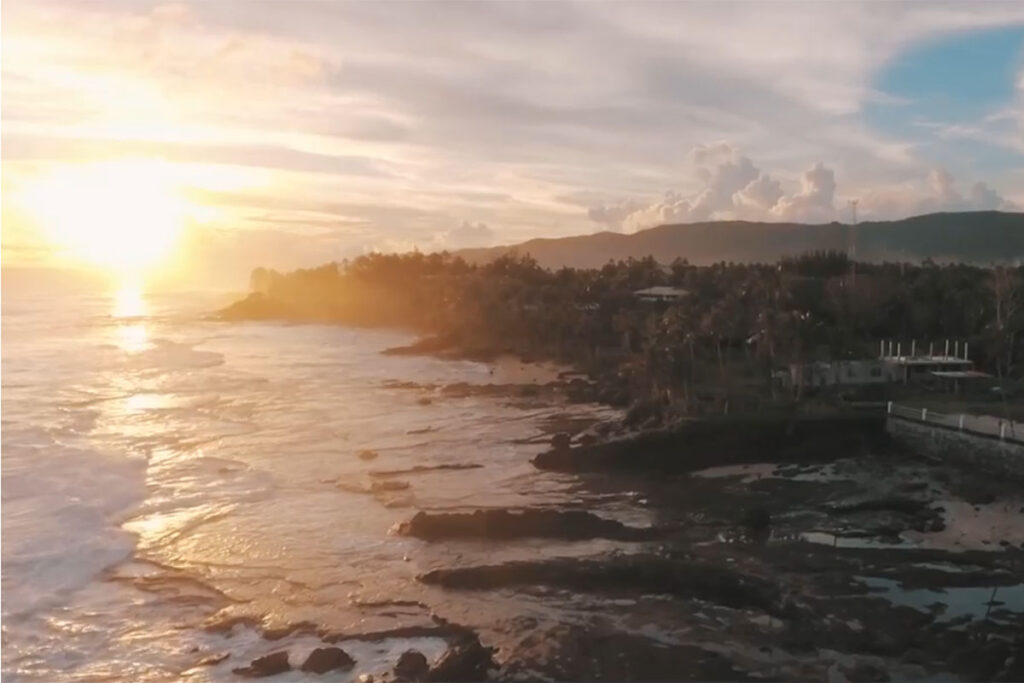
There are two season in Samoa. A dry season and a wet season. The dry season extends from May through October. The wet season is from November through April. During the dry season temperatures range from 73-84°F. During the wet season temperatures are slightly higher, 75-86°F. Either season provides excellent fishing, although during the wet season the sea can get a little rough. For shore fishing in the lagoons and near-shore reefs, where conditions are more sheltered, fishing is excellent year round.
Avoiding the Crowds
If you want to make the most of your fishing trip to Samoa, it will help to avoid the crowds. Fewer people means more territory to fish and it’s easier to get permission to fish from shore. July and August are the international tourist season. From mid-December to mid-January Samoans living overseas return home for the holidays. If avoiding the masses is a priority, anglers will plan their trip sometime between February and March.
However, the shoulder seasons of April through June and September through November have something to offer. April and May come on the tail end of the rainy season, so if you arrive in either of these month expect precipitation. If you want the best possible conditions, I highly recommend planning your trip right before the onset of the wet season in September or October. These are quiet months on the island and the weather is ideal for fishing.
Peak Seasons by Species
Again, there isn’t a bad season to fish the Samoan Islands. That’s one of the beauties of planning a fishing trip to Samoa. But there are certain months that will produce better catch rates—and potentially larger catches—for certain fish species. The following are the peak fishing seasons for some of the more popular gamefish species.
| Fish species | Peak season |
|---|---|
| Yellowfin Tuna | November to May |
| Dogtooth Tuna | September to November |
| Wahoo | September to November |
| Mahi Mahi | September to November |
| Blue Marlin | November to May |
| Black Marlin | September to November |
| Pacific Sailfish | September to November |
| Giant Trevally | January to April |
Even though each of the species has a peak fishing season, you’ll find most of them in abundance year round.
Fish Species
There are over 991 species of fish found from the shorelines of the four American Samoa Islands to the ocean beyond the outer reefs.
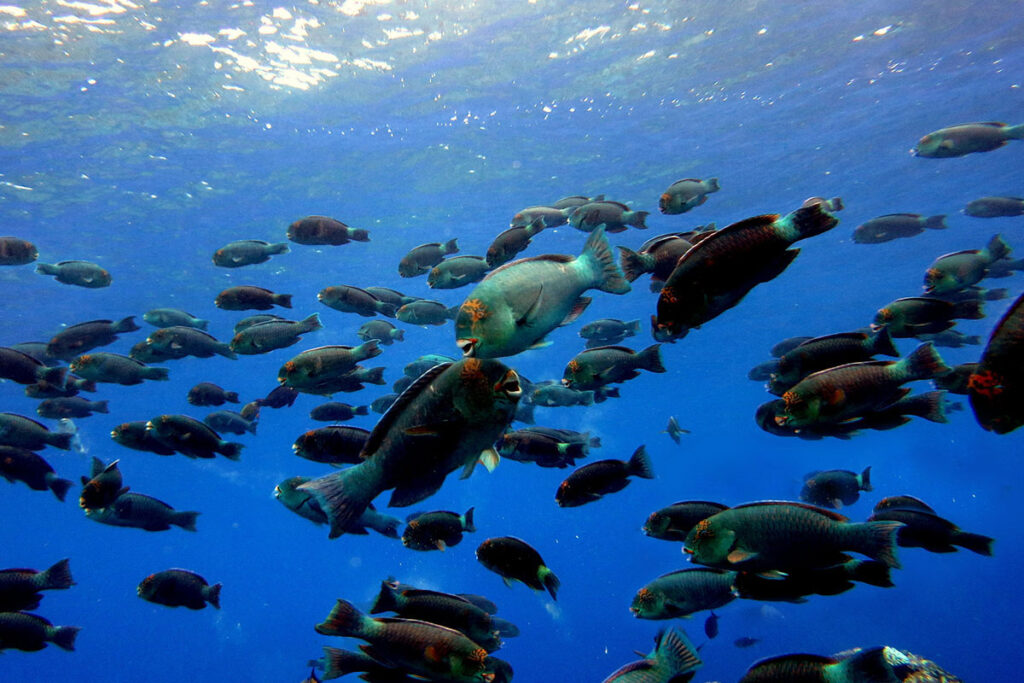
| Bigeye Emperor | Wahoo |
| Bigeye Scad | Mahi Mahi |
| Humpback Snapper | Blue Marlin |
| Crimson jobfish (snapper) | Black Marlin |
| Grouper | Pacific Sailfish |
| Jacks | Broadbill Swordfih |
| Yellowfin Tuna | Giant Trevally |
| Dogtooth Tuna | Spanish Mackerel |
| Skipjack | Surgeonfish |
| Mangrove Jacks | Pacific Barracuda |
Rules, Regulations and By-laws
The near-shore reefs and fisheries adjacent to local villages are governed in accordance to village by-laws established in cooperation with the national Fisheries Legislation. These by-laws give villages the right to restrict fishing prividges and set limits on the type and size of fish that may be harvested. They may also restrict the type of fishing gear and equipment that may used. By-laws vary from village to village and it’s your responsibility to (1) obtain permission to fish in village waters and (2) abide by local by-laws.
If you hire a charter to take you out beyond the reefs, you’re operator will know where it’s okay to fish and where it isn’t. If you decide to fish on your own, from shore or on any of the inshore reefs, you need to be aware of fishing rules and regulations.
Best practices and advisories:
- Always obtain permission before fishing near-shore waters.
- Don’t fish on Sunday – it’s the Samoan day of rest.
- Abide by all village by-laws when fishing.
- Make sure your fishing gear adheres to village standards.
- Check weather conditions before going on the water.
- Fish only for personal use. It is illegal to sell catches.
- Make sure you know where you’re fishing at all times.
- Large predatory fish may contain unhealthy levels of mercury.
- Some large grouper and reef fish may have Ciguatera poisoning. Use caution when harvesting these species for consumption.
All fishing regulations apply to fresh and saltwater fish species, as well as mollusks and shellfish.
The following activities are prohibited:
- Chumming with natural or artificial substances.
- Using live or dead bait fish for freshwater fishing.
- Commercial fishing.
- Using drugs, explosives, electricity or poisons for the purposes of harvesting fish.
- Digging for bait in public lands.
- Failing to release fish that do not meet size or species requirements.
- Fishing from road bridges or within 200 feet of areas designated for general public use.
- Introducing foreign wildlife or invasive species into the park ecosystem.


